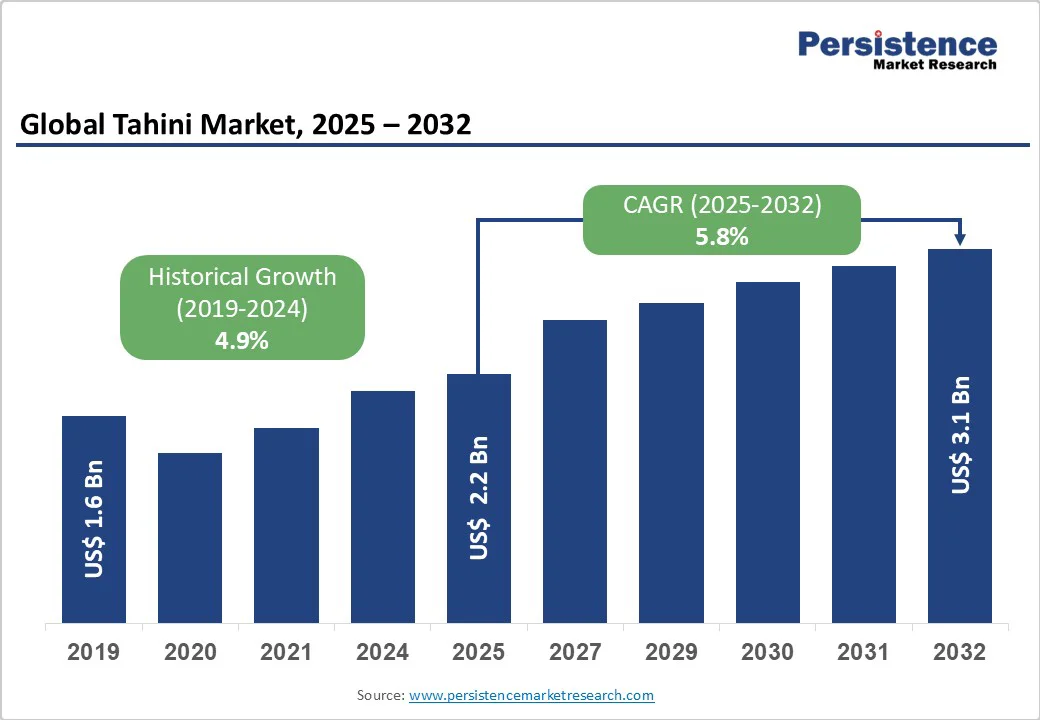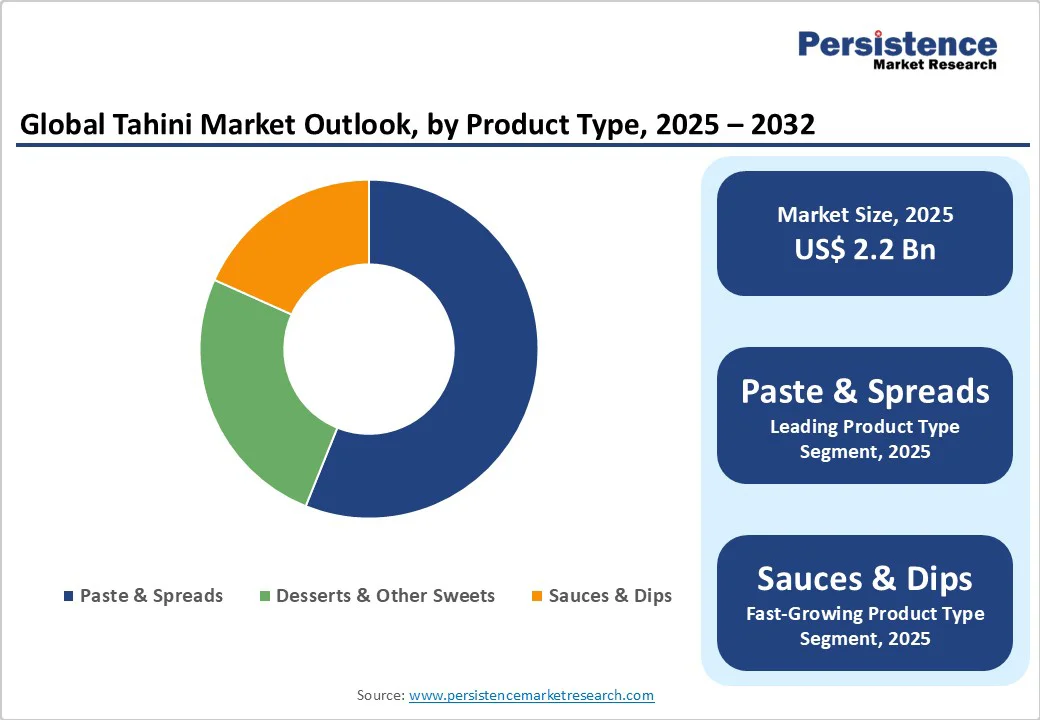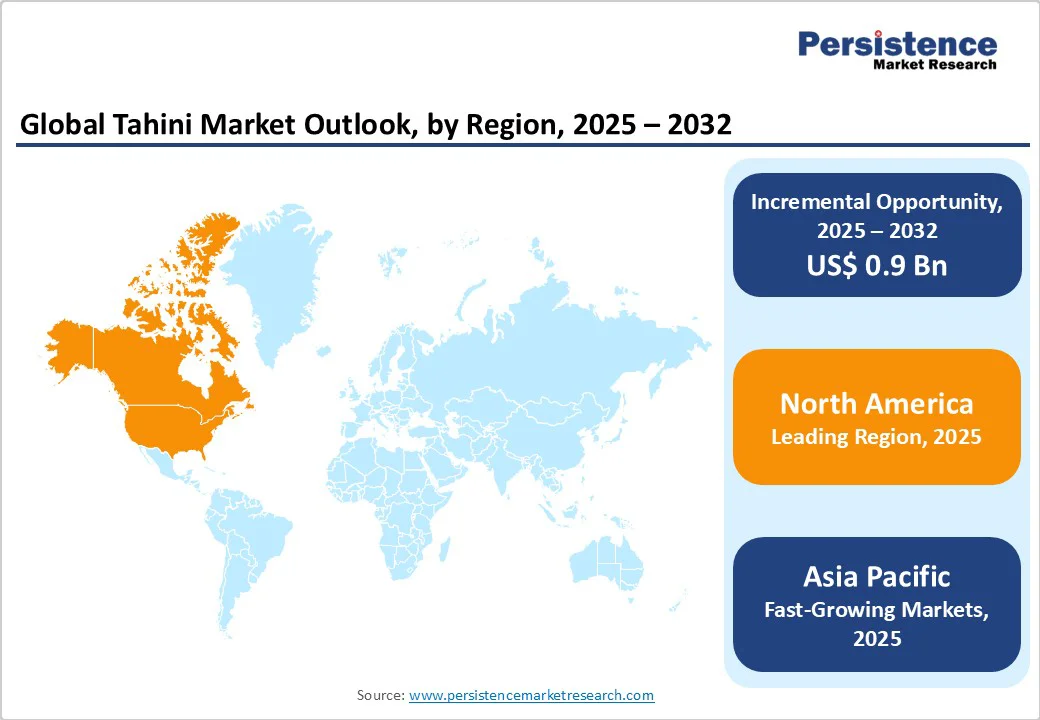ID: PMRREP12883| 186 Pages | 14 Oct 2025 | Format: PDF, Excel, PPT* | Food and Beverages

The global tahini market size is likely to value US$ 2.2 billion in 2025 and is projected to reach US$ 3.1 billion by 2032, growing at a CAGR of 5.8% during the forecast period from 2025 to 2032.
Tahini is made from ground sesame seeds which is a staple ingredient in Mediterranean and Middle Eastern cuisines, commonly used in dishes such as hummus and baba ganoush.
It also finds applications in certain Asian recipes, including Japanese miso soup. In recent years, its use has expanded into salads, contributing to broader market growth.
Research highlights several health-related benefits of tahini, suggesting its role in reducing the risk of premature hair graying, aiding skin detoxification, and helping prevent conditions such as rheumatoid arthritis.
| Key Insights | Details |
|---|---|
| Tahini Market Size (2025E) | US$ 2.2 Bn |
| Market Value Forecast (2032F) | US$ 3.1 Bn |
| Projected Growth (CAGR 2025 to 2032) | 5.8% |
| Historical Market Growth (CAGR 2019 to 2024) | 4.9% |

The increasing use of tahini pastes and sauces in the hotel, restaurant, and catering (HoReCa) sector is a significant driver of the global tahini market. Restaurants and hotels are progressively incorporating Mediterranean and Middle Eastern dishes such as hummus, baba ganoush, and tahini-based dressings into their menus to cater to the rising demand for ethnic and healthy cuisines.
Tahini’s distinctive nutty flavor, creamy texture, and versatility make it a preferred ingredient for chefs seeking to enhance culinary experiences. In addition, the growing trend of casual dining and gourmet food outlets has expanded opportunities for the adoption of tahini in dips, sauces, and specialty dishes.
Many foodservice establishments are also using packaged and ready-to-use tahini products for convenience, ensuring consistent quality and taste. For example, in April 2024, Subway Canada launched a globally inspired menu featuring a Shawarma Chicken Rice Bowl drizzled with tahini and other sauces.
This expansion in the HoReCa segment, coupled with rising consumer awareness of tahini’s nutritional benefits, including protein content, healthy fats, and antioxidants, is expected to significantly boost overall demand and drive market growth globally.
Despite growing popularity, the global tahini market faces certain restraints that may limit its expansion. One key challenge is the relatively high price of premium and organic tahini products compared to conventional spreads and sauces, which can deter price-sensitive consumers, particularly in emerging markets.
Additionally, limited awareness about tahini’s versatility and nutritional benefits in certain regions slows adoption, especially in countries where Mediterranean and Middle Eastern cuisines are not widely consumed. Shelf-life and storage requirements also pose challenges, as tahini can spoil if not stored properly, impacting both manufacturers and retailers.
Supply chain disruptions and fluctuations in sesame seed availability due to climate conditions or agricultural issues can further constrain production and pricing stability. Furthermore, competition from alternative spreads and nut-based pastes, such as peanut or almond butter, may limit market growth. These factors collectively act as key restraints for the tahini industry globally.
The global tahini market presents several significant growth opportunities driven by changing consumer preferences and culinary trends. Rising demand for plant-based, vegan, and health-focused foods is boosting tahini consumption as it is a nutrient-rich source of protein, healthy fats, and antioxidants.
Expanding awareness of Mediterranean and Middle Eastern diets is increasing adoption in both developed and emerging regions. Tahini’s versatility offers opportunities for product innovation in spreads, dips, sauces, salad dressings, bakery items, and even beverages such as smoothies and energy drinks.
Growth in the hotel, restaurant, and catering (HoReCa) sector, along with rising casual dining and gourmet food outlets, further enhances market potential. E-commerce expansion and online retail platforms provide easier access to premium and specialty tahini products, reaching a wider consumer base. Additionally, the introduction of organic and flavored variants allows brands to cater to evolving tastes, driving market penetration and long-term growth prospects globally.
In 2024, the paste and spread segment accounted for the largest revenue share of 56.1% in the global tahini market. Tahini paste continues to be a key ingredient in hummus preparation, while spreads are popularly paired with bread, baked goods, and various Asian-inspired dishes. Its distinctive nutty flavor and smooth texture make it a preferred choice for a wide consumer base.
Additionally, the rising global presence of Middle Eastern cuisine and the regular inclusion of hummus and Mediterranean recipes on menus are anticipated to further strengthen this segment’s growth. On the other hand, the sauces and dips category is projected to be the fastest-growing segment.
These products are increasingly favored by both households and commercial establishments to enhance taste and enrich dining experiences. The wide range of tahini-based sauces and dips offered by food manufacturers is also fueling their adoption in everyday cooking.
By distribution channel, the modern trade segment continues to lead the global tahini market, supported by the strong presence of supermarkets and hypermarkets offering a wide variety of packaged tahini products. The convenience of one-stop shopping, better visibility of international and ethnic food brands, and attractive promotional offers have made modern trade a preferred channel for consumers across urban markets.
This segment holds the largest share due to its ability to provide consistent product availability and cater to diverse consumer preferences. Alongside, the online store segment is emerging as the fastest-growing channel. The rising adoption of e-commerce platforms, increasing popularity of home delivery, and growing awareness of Mediterranean and Middle Eastern food products have significantly boosted online tahini sales. Additionally, digital marketing campaigns, discounts, and easy access to global brands are fueling consumer shift towards online purchases, making it the most dynamic.

In North America, the tahini market is primarily driven by the rising popularity of Mediterranean and Middle Eastern cuisines, along with growing consumer interest in healthy and plant-based foods.
The U.S. dominates the regional market due to the presence of numerous foodservice establishments offering Mediterranean cuisine and the wide availability of tahini products across retail categories, offered in various packaging types, sizes, and specialty options, including organic varieties.
Canada, while smaller in market size, is emerging as the fastest-growing market thanks to the increasing adoption of vegan and organic products. Consumers are also becoming more aware of tahini’s nutritional benefits, including protein content, healthy fats, and antioxidant properties, which is further fueling demand.
Supermarkets, hypermarkets, and online retail platforms are the main distribution channels, with online stores witnessing rapid growth driven by e-commerce expansion. Overall, the North American market is expected to continue growing steadily as ethnic foods gain mainstream acceptance and product innovations expand the range of tahini-based offerings.
The Asia Pacific tahini market is experiencing rapid growth, driven by increasing consumer awareness of healthy and plant-based diets, rising disposable incomes, and urbanization. Countries such as China, Japan, and Australia are leading the region, with China emerging as the fastest-growing market.
Tahini is increasingly being incorporated into spreads, sauces, dressings, and snacks, as well as in innovative applications such as energy bars and beverages, catering to health-conscious and convenience-seeking consumers. The growing popularity of vegan and vegetarian diets further supports market expansion.
Modern trade channels, including supermarkets, hypermarkets, and online retail platforms, are key distribution avenues, offering consumers easy access to premium and organic tahini products. Additionally, the HoReCa sector in urban areas is expanding its use of tahini in restaurants and cafes, providing further growth opportunities for the region. Overall, the Asia Pacific is poised for sustained market development in the coming years.
The Middle East and Africa (MEA) region is a traditional stronghold for tahini consumption. Israel leads the market in terms of per capita consumption, while Gulf countries are experiencing the fastest growth due to increasing expatriate populations, rising disposable income, and greater availability of packaged tahini in supermarkets.
North African countries such as Egypt and Morocco are also contributing to market expansion with growing retail and HoReCa adoption. Modern trade channels dominate in urban centers, whereas traditional retail remains important in rural areas.
Increasing awareness of health benefits, combined with global food trends and online retail growth, is driving overall tahini demand in the MEA region. New product launches and premium tahini variants are expected to further accelerate market growth across the region.

The global tahini market is highly competitive, characterized by the presence of numerous international and regional players offering diverse product portfolios. Companies focus on product innovation, organic and specialty variants, and strategic distribution through modern trade, online platforms, and foodservice channels to gain market share.
Brand reputation, quality consistency, and pricing strategies play a key role in consumer preference. Collaborations, mergers, and acquisitions are common strategies to expand regional presence and strengthen supply chains. Leading players also emphasize marketing campaigns highlighting tahini’s health benefits and culinary versatility to attract health-conscious and ethnic-food-seeking consumers, driving overall market competitiveness.
The global tahini market is likely to value at US$ 2.2 Bn in 2025.
Increasing consumer awareness of Mediterranean diets, growing vegan population, nutritional benefits of sesame seeds, and rising adoption in bakery and confectionery products.
The global market is poised to witness a CAGR of 5.8% between 2025 and 2032.
Rising demand for plant-based foods, ethnic cuisines, health-focused diets, and tahini’s expanding applications in snacks, spreads, and dressings.
Dipasa USA, Sunshine International Foods, Inc., Kevala International LLC, Premier Organics Joyva Corp., and others are some of the key players in the market.
| Report Attribute | Details |
|---|---|
| Historical Data/Actuals | 2019 - 2024 |
| Forecast Period | 2025 - 2032 |
| Market Analysis | Value: US$ Bn and Volume (if Available) |
| Geographical Coverage |
|
| Segmental Coverage |
|
| Competitive Analysis |
|
| Report Highlights |
|
By Product Type
By Packaging Size
By Distribution Channel
By Region
Delivery Timelines
For more information on this report and its delivery timelines please get in touch with our sales team.
About Author